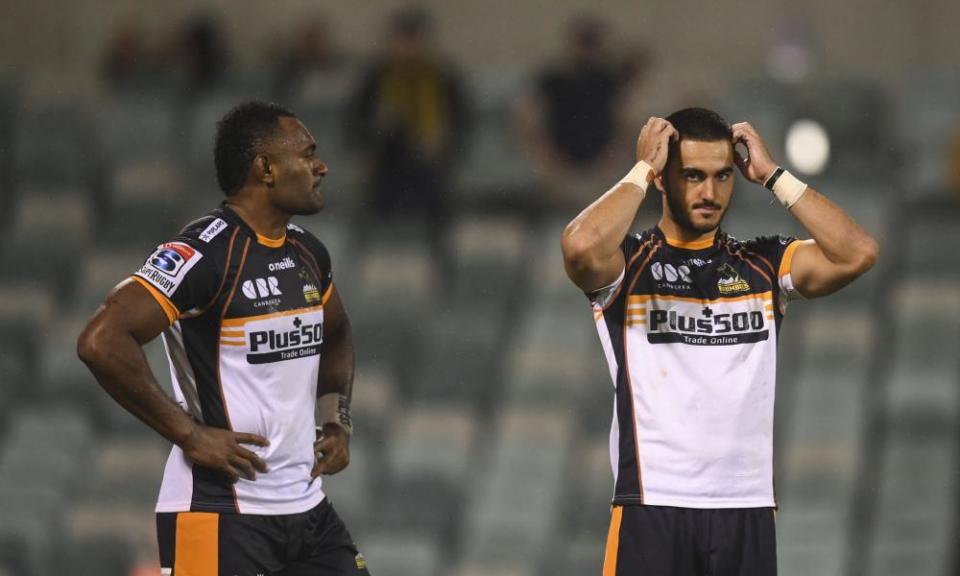Rugby Australia banks on TV package to be greater than sum of its parts

In the Seinfeld episode The Pitch, Jerry and George propose an idea for a “show about nothing” to American television network NBC. When the fictional NBC executive Russell Dalrymple asks them: “Why am I watching it?”, George replies: “Because it’s on TV.” Dalrymple says: “Not yet.”
Rugby Australia is pitching a “whole of game” package to broadcasters, including Optus, in an attempt to achieve a significant uplift on its current $57m-a-year deal with Fox Sports. The package involves the Wallabies, Wallaroos, Australia’s four Super Rugby teams, the men’s and women’s Olympic sevens teams, the National Rugby Championship and a new national club competition.
Related: Alarm bells set off with Rugby Australia seeking new broadcast deal | Bret Harris
Importantly, Rugby Australia is seeking free-to-air coverage for Super Rugby to grow the game beyond the confines of pay TV where it has been with Fox Sports for the past 25 years. But will disgruntled rugby fans watch all of this content just because it’s on TV?
Of all those rugby products, so to speak, it is only the Wallabies – and to a lesser extent the NSW Waratahs and Queensland Reds – who have any real capacity to generate TV ratings and subscriptions to drive revenue for the game. The rest of the products are costs, investments if you like, rather than income generators, although the national sevens programs receive valuable Olympic funding.
Yet, Rugby Australia has bundled all of these products together in a “love me, love my dog” approach to the broadcast negotiations. RA is banking on the “whole of game” package to be greater than the sum of its parts, echoing the TEAM acronym – together everyone achieves more.
There must be something attractive about the whole-of-game package because Fox Sports attempted to spoil RA’s strategy by making a play for the rights to the Sydney and Brisbane club competitions. In a rare show of unity in Australian rugby the clubs decided to remain with RA.
Why did Fox Sports try to secure club rugby? The pay TV network had never shown much interest in the grassroots before. It suggested RA’s TV rights would be more valuable if it went to market with a comprehensive package.
RA was desperate to include Sydney and Brisbane club rugby, even to the point of negotiating a $3.7m buyout from current rights holders Channel Seven and Club Rugby TV to return the Sydney club rugby rights to the Sydney Rugby Union. But since 2015 it was costing the Sydney clubs $300,000 a year to have their games shown on 7Two, while ratings have reportedly declined since matches were televised on the ABC.
How will club rugby, which has intangible benefits as a community program, add commercial value to RA’s broadcast agreement?
RA has confirmed it is investigating a national club competition, but the format will not be determined until consultation with the successful broadcaster. There has been strong speculation RA will create an FA Cup-style knockout competition involving Australia’s top clubs. A national club competition is an appealing concept, but RA must ensure the costs do not outweigh the benefits.
Following the initial success of the National Soccer League and the National Basketball League in the 1970s and 1980s there was a rush to national sporting competitions. Every sport from tiddlywinks to Twister seemed to go national, but national competitions are not for everyone. Geographically, Australia is the sixth biggest country in the world. It is difficult for minor sports – or competitions – to compete nationally because of travel and accommodation costs unless they are subsidised.
Whatever club concept RA decides to follow, it must make sure it is based on a sound economic model or the competition could potentially erode any financial gains achieved in the new broadcast deal in the same way the costs of Super Rugby over-expansion wiped out previous increases in TV revenue.
The “rainmakers” in Australian rugby remain the Wallabies, Waratahs and Reds, who subsidise just about everybody else. RA is hoping the new Wallabies head coach, Dave Rennie, will turn the Australian team around, lifting them up from seventh in the world, their worst ever result, to a top-two or top-three position.
But Rennie needs Australia’s Super Rugby teams to prepare players for Test rugby. The signs so far are not encouraging. After three rounds of the new season Australia’s teams are zero and six against foreign opposition, while three of the four sides are in the bottom half of the table.
There are already predictions the winless Waratahs’ season is over following their 24-10 defeat against the Melbourne Rebels in the Victorian capital on Friday, while the Reds are also winless after losing against the Jaguares 43-27 in Buenos Aires on Sunday. At least the Brumbies showed they were competitive in their heartbreaking 23-22 defeat by the Highlanders in Canberra on Saturday but, sadly, they do not rate on TV.
Australian rugby is in danger of becoming a show about nothing, or at least, nothing much. The Big Three – Wallabies, Waratahs and Reds – must start winning because no one is going to watch just because they are on TV.

